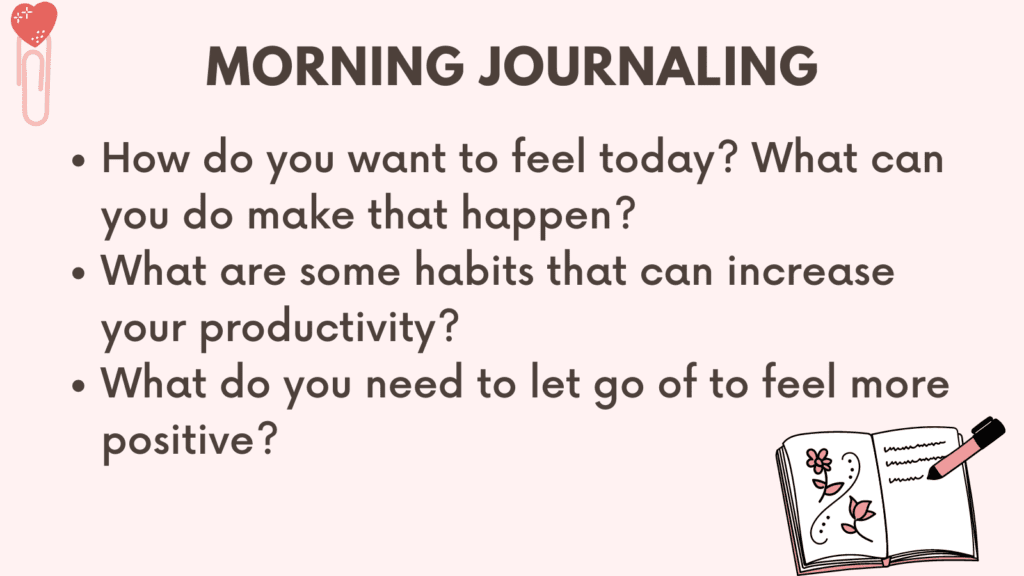This post contains some of the best journal prompts for releasing difficult emotions.
Journal Prompts for Releasing Difficult Emotions
1. Write about a recent event or situation that triggered strong emotions in you. Describe how you felt and why.
2. What is one emotion that you often struggle with? Explore its origins and any patterns you notice.
3. Describe a time when you felt overwhelmed by your emotions. What did it feel like, and how did you cope?
4. Reflect on a difficult decision you had to make. How did you feel before, during, and after making the decision?
5. Write a letter to someone who has caused you emotional pain. Express your feelings and thoughts honestly without intending to send the letter.
6. What is one fear that frequently holds you back? Explore where this fear stems from and how it affects your life.
7. Take a moment to describe an emotion that you find challenging to express. What might be preventing you from fully experiencing and expressing it?
Related: How To Feel Your Feelings? Top 9 Difficult Emotions To Cope With In Healthy Ways
8. Write about a past disappointment or failure. How did it impact your emotions, and what have you learned from the experience?
9. Explore the connection between your emotions and your physical sensations. How do different emotions manifest in your body?
10. Write a list of things that currently bring you joy or make you feel good. Reflect on why these activities or experiences have such a positive impact on your emotions.
11. Describe a recent situation where you felt a strong sense of anger. What triggered it, and how did you handle it?
12. Write about an emotion that you’ve been avoiding or suppressing. Explore why you might be resistant to experiencing or expressing it.
13. Reflect on a time when someone invalidated your emotions. How did it make you feel, and how can you work towards validating your own emotions?
Related: Dysregulated Nervous System: Top 9 Signs & How to Heal
14. Write a letter of forgiveness to yourself regarding a past mistake or regret. Be compassionate and offer yourself understanding and acceptance.
15. Explore the connection between your emotions and your core beliefs or values. How do they influence each other?
16. Write about a time when you felt deep sadness or grief. What were the circumstances, and how did you process those emotions?
17. Reflect on a past relationship that caused you emotional pain. What lessons have you learned, and how has it shaped your current emotional experiences?
18. Describe a recent situation where you experienced a sense of overwhelming joy or happiness. What brought about these positive emotions?
19. Explore the connection between your emotions and your self-worth. How does your perception of yourself impact your emotional well-being?
20. Write about a fear that you’d like to overcome. Explore strategies you can use to gradually face and release this fear.
Related: Top 21 Emotional Writing Prompts To Process Emotions
21. Reflect on a time when you felt a sense of shame or guilt. What contributed to these emotions, and how can you work towards self-forgiveness?
22. Describe a situation where you felt emotionally vulnerable. How did you handle it, and what did you learn from being vulnerable?
23. Write a gratitude list focusing specifically on emotions or emotional experiences you are grateful for.
24. Reflect on a time when you experienced a sense of relief. What led to this feeling, and how did it impact your overall well-being?
25. Explore a recurring negative thought pattern that affects your emotions. Challenge and reframe this pattern to promote more positive emotional experiences.
26. Write about a time when you felt a sense of empowerment. What influenced this feeling, and how can you cultivate more empowering experiences?
Related: The Difference Between Pain And Suffering (+Top 4 Tips On How To Embrace Pain & Stop Suffering)
27. Reflect on a past trauma or challenging experience. Describe how it impacted your emotions at the time and how you’ve worked towards healing.
28. Write a love letter to yourself, expressing appreciation for who you are and acknowledging your emotions with kindness.
29. Describe a situation where you experienced envy or jealousy. Reflect on the underlying emotions and how you can shift towards a more positive mindset.
30. Explore the connection between your emotions and your personal boundaries. How do boundaries affect your emotional well-being?
31. Write about a time when you felt emotionally stuck or stagnant. What contributed to this state, and how can you actively work towards emotional growth?
32. Reflect on a recent conflict or disagreement that affected your emotions. What could you have done differently to address the situation more effectively?
33. Describe a time when you felt a deep sense of compassion or empathy towards someone. How did this emotional experience impact your relationship with that person?
34. Explore the connection between your emotions and your self-care practices. How can you prioritize self-care to support your emotional well-being?
35. Reflect on a time when your expectations led to disappointment or frustration. How did you handle these emotions, and what adjustments can you make in your expectations?
Related: Negative Core Beliefs List (& 8 Tips On How To Challenge Them)
How to Use Journal Prompts for Releasing Difficult Emotions?
1. Create a Safe Space
Before you begin journaling, create a safe and comfortable space for yourself.
Find a quiet place where you can be alone and undisturbed.
Consider turning off your phone or any other potential distractions.
Creating a calm environment helps facilitate the introspective process and encourages emotional exploration.
2. Choose the Right Time
Select a time when you are relatively relaxed and have ample time for reflection.
It could be in the morning before starting your day, during a quiet evening moment, or whenever you feel most open and receptive to journaling.
Allow yourself the freedom to fully engage in the writing process without feeling rushed or overwhelmed.
3. Reflect on Your Emotions
Before diving into the journal prompts, take a few moments to reflect on your emotions.
Identify the emotions that you want to address and release.
Are you feeling angry, sad, anxious, or overwhelmed?
Understanding and naming your emotions will help you approach the journaling process with intention and focus.
Related: How To Do Thought Work In 3 Simple Steps
4. Choose Relevant Prompts
Carefully select journal prompts that directly address the emotions you wish to release.
The prompts provided earlier in this article offer a variety of starting points for exploring different emotions.
Pick one prompt or a combination of prompts that resonate with you at that moment.
5. Begin Writing
Start writing freely and allow your thoughts and emotions to flow onto the paper.
Do not worry about grammar or sentence structure; this is a personal and uninhibited process.
Let your emotions guide your writing and be as honest and authentic as possible.
6. Dig Deep
As you respond to each prompt, go beyond surface-level descriptions.
Challenge yourself to delve deeper into the underlying causes, triggers, and patterns related to the specific emotion you are exploring.
Ask yourself thought-provoking questions that encourage self-reflection and introspection.
Related: Forgiving Someone Who Isn’t Sorry: 9-Step Guide To Free Yourself From The Past
7. Be Vulnerable
Throughout your writing, embrace vulnerability.
Acknowledge your feelings without judgment or criticism.
Give yourself permission to express emotions that may have been suppressed or ignored.
Remember that this is a safe space for you to be open and honest with yourself.
8. Practice Self-Compassion
During the journaling process, be kind and compassionate towards yourself.
Treat your thoughts and emotions with understanding and acceptance.
Avoid criticizing or invalidating your experiences.
Instead, offer yourself gentle encouragement and support.
Related: How To Be Gentle With Yourself? Top 5 Ways To Practice Self-Compassion
9. Explore Triggers and Patterns
Identify any common triggers or patterns that contribute to the difficult emotions you are addressing.
Are there specific situations, people, or thoughts that consistently evoke these emotions?
Understanding these triggers can empower you to develop strategies for emotional regulation and finding healthier coping mechanisms.
10. Seek Perspective
Consider alternative perspectives on the emotions you are experiencing.
Challenge any distorted or negative thinking patterns that may perpetuate your difficult emotions.
Look for evidence that contradicts these thoughts and embrace more balanced and realistic perspectives.
11. Reflect and Review
Regularly review your journal entries to identify patterns, progress, and areas that may require additional attention.
Notice any changes in the intensity or frequency of difficult emotions.
This self-reflection can provide valuable insight into your emotional well-being and serve as a guide for future personal growth.
Related: Best 18 Self Compassion Journal Prompts (+FREE Worksheets)

Conclusion
Using journal prompts for releasing difficult emotions can be a therapeutic and empowering practice.
Remember to be gentle and compassionate with yourself throughout the process, and seek professional support if needed.
Journaling can be a valuable tool in your journey towards emotional well-being and personal growth.



